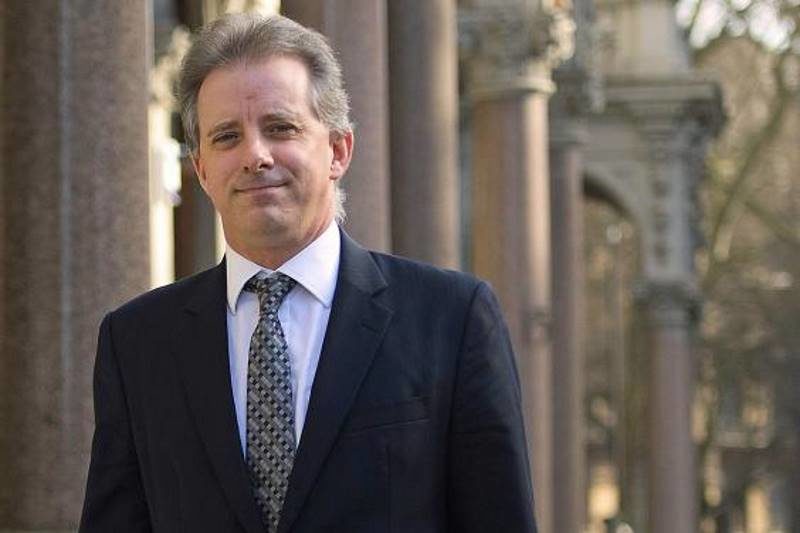
That a private investigator, highly paid by the Clinton campaign to find dirt about Trump, was acting out of decency, would be unbelievable in the best case. But the piece is way worse. There are at least six factual errors in it which anyone who has followed the affair can easily detect. Some new allegations in the piece are so thinly sourced that any decent editor would have thrown them out.
The first graph is already a mess:
In January, after a long day at his London office, Christopher Steele, the former spy turned private investigator, was stepping off a commuter train in Farnham, where he lives, when one of his two phones rang. He'd been looking forward to dinner at home with his wife, and perhaps a glass of wine. It had been their dream to live in Farnham, a town in Surrey with a beautiful Georgian high street, where they could afford a house big enough to accommodate their four children, on nearly an acre of land. Steele, who is fifty-three, looked much like the other businessmen heading home, except for the fact that he kept his phones in a Faraday bag-a pouch, of military-tested double-grade fabric, designed to block signal detection.A phone, kept in a Faraday bag designed to block signals, rings? How please can a phone that can not send or receive signals, take a call? That is impossible. How can a fact-checker and/or editor at The New Yorker let such nonsense slip into the opening graph of such a large piece?
A friend in Washington, D.C., was calling with bad news: ...
Marcy Wheeler aka Emptywheel, with whom I have exchanged views on this, details several of the factual errors in the piece:
- The piece misleads the reader by insinuating that Steele was original paid by Republican money. GPS Fusion was paid by a Republican opponent of Trump to find dirt on him. That job ended after Trump had won the primaries. GPS Fusion then started to work for the Clinton campaign. Steele was hired by GPS only after the GPS client had changed. He was then tasked with finding something "Russian" on Trump.
- Mayer claims that the Democrats were only alarmed about the "hacking" of the DNC emails after, in late July 2016, Wikileaks started to publish those. That is wrong. Marcy points out that one month earlier the Guccifer 2.0 figure had already published internal details from the DNC "hack". That, at the latest, set off the alarm bells.
- Mayer also claims that none of reporters who were briefed by Steele then wrote about the dossier. But Michael Isikoff did write about it without revealing that Steele was his source. His report was used by the FBI as a confirmation of the Steele claims.
It's too early to make a final judgment about how much of Steele's dossier will be proved wrong, but a number of Steele's major claims have been backed up by subsequent disclosures.That the Steele dossier was backed up by subsequent disclosures would be news to me. What evidence does Mayer have to support that?
His allegation that the Kremlin favored Trump in 2016 and was offering his campaign dirt on Hillary has been borne out.No, it has not. Dirt on Clinton was offered to the Trump campaign by one Rob Goldstone, a British lobbyist who tried get a date with the campaign for a Russian lobbyist hired by some oligarch who wanted to get rid of sanctions enacted against him. A meeting with both lobbyists was held in the Trump Tower but cut short when it became obvious that they could not provide any dirt on Clinton. This had nothing to do with Steele or the content of his dossier.
So has his claim that the Kremlin and WikiLeaks were working together to release the D.N.C.'s e-mails.No evidence exists to support that claim. Wikileaks, Craig Murrey and Kim Dotcom have consistently said that the DNC emails Wikileaks published did not come from a "hack" or from Russian sources and that Russia was not involved in their release. This again has nothing to do with the dossier.
Indeed, it's getting harder every day to claim that Steele was simply spreading lies, now that three former Trump campaign officials-Flynn, Papadopoulos, and Rick Gates, who served as deputy campaign chairman-have all pleaded guilty to criminal charges, and appear to be cooperating with the investigation.And again: None of the cases against those persons had anything to do with Steele or his dossier. They pleaded guilty on unrelated issues.
None of these three points Jane Mayer makes is supporting the claimed veracity of the Steele dossier or any part of it. She is evidently misleading the readers by claiming that they do so.
There are some details in the Mayer piece that could be news and would normally deserve some discussion. But the piece is full of obvious errors, unreliable arguments and its sourcing is very thin. Thus nothing in it can be taken at face value.
The famous fact checking of The New Yorker completely failed with this piece. It is sad that the once venerable magazine and the admirable Jane Mayer have become willing propagandists for this lost cause.



Comment: It is amazing that after all this time and zero confirmation for the allegations in the 'dodgy dossier', people who call themselves journalists are still trying to make a case out of it. And by the way, did Jane Mayer miss the memo?